Motorola Droid 3 Review - Third Time's a Charm
by Brian Klug on July 30, 2011 12:01 AM ESTDisplay - qHD RGBW 4”
The original Droid and Droid 2 famously used high quality 3.7” IPS panels, and as a result had excellent contrast and brightness. What always struck me as being a little odd with the arrangement was that the devices used the 16:9 FWVGA (854 x 480) aspect ratio instead of WVGA’s 800x480. The difference was subtle, but as a result the Motorola Droids always did seem more rectangular than most of their other Android bretheren. Since then, qHD has become the hot new high-end Android resolution, which vindicates Motorola’s by likewise being 16:9.
Aspect ratios aside, it’s interesting to me how obvious it is that qHD is the answer to the iPhone 4’s retina display. I’ve been told that the development cycle for most of these handsets is anywhere from 12 to 18 months, and look no further than your calendar and when qHD devices have started shipping to see that in action. Whatever the reason for qHD’s emergence, it’s good to have some display innovation take place.
The Droid 3 ups the size of the primary display from the 3.7” which adorned the old Motorola Droids to 4.0”, and as already noted increases effective resolution from 854x480 to 960x540. Like the Droid X2 and other new qHD Motorola phones, the Droid 3 uses a PenTile L6W RGBW subpixel matrix to achieve effective qHD resolution. I talked about RGBW in the Droid X2 review, and what it boils down to is the inclusion of a fourth white subpixel which increases light transmittance (and thus reduces required backlight power) in a lot of use cases.
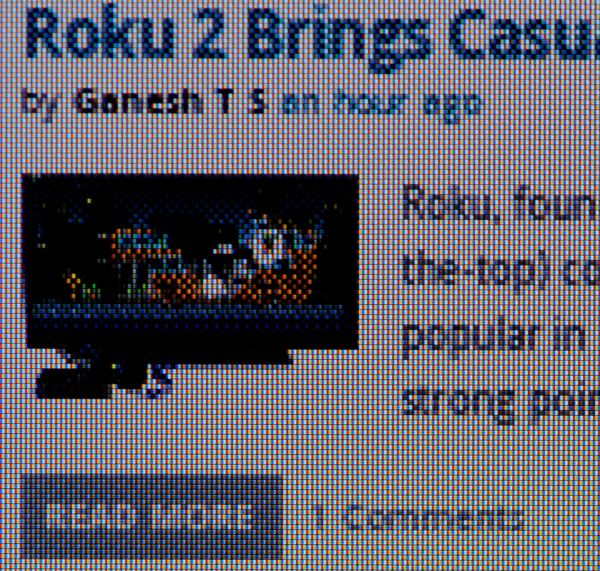

Left: Droid 3 with RGBW PenTile, Right: Droid 2 with RGB Stripe
Unlike the other RGBG PenTile which adorned AMOLED displays before Super AMOLED Plus swung around, I find RGBW much easier to stomach and completely readable when presented with black on white UIs. Colors still have visible grain, as do some UI elements, but the Droid 3’s 4” display makes this considerably less noticeable than the same resolution on the Droid X2. Only on bright colors is that extra space due to the fourth subpixel readily visible, and thanks to our color-specific visual acuity, greens are the most visible.
I immediately noticed out of the box with the Droid 3 that it wasn’t as super bright as the Droid X2, which was itself almost shockingly bright. That said, the Droid 3 is no slouch and is likewise nice and contrasty as well.
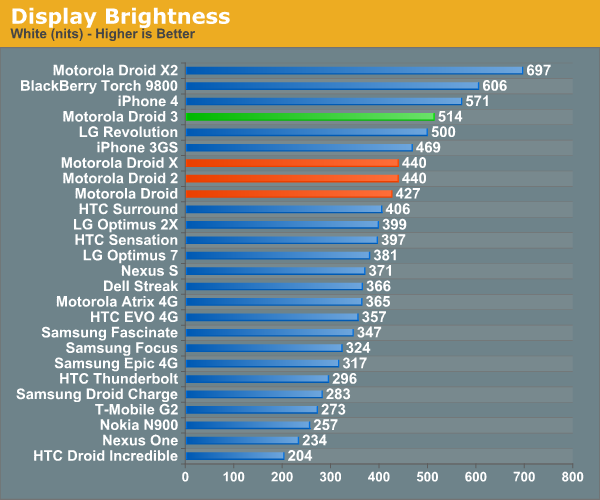
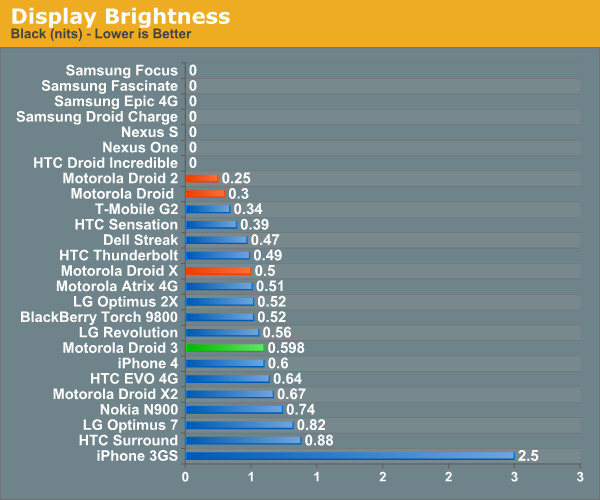

We’re still making plots of brightness (white and black), and white point at 25% brightness steps. The Droid 3’s white point tracking is slightly different from the X2’s despite also using RGBW. It ends up not being visibly blue like some of the AMOLED variants nor noticeably warm like some of the earlier Droid panels were in odd batches.

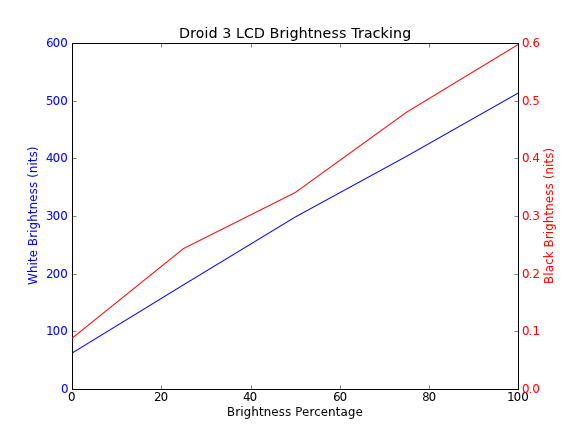
The next are of concern are viewing angles, which in my opinion the Droid 3 does very well at. I stuck the Droid 3 next to the Droid 2 and shot some pics of it at different angles. It’s surprising to me in retrospect how much color shift and contrast reduction there is in the old Droid 2 by comparison. In this regard, the Droid 3’s display is a clear step forwards.
Outdoor viewing angles are decent on the Droid 3 are pretty good but not totally perfect. RGBW helps keep brightness punchy but in my mind outdoor viewing remains an unsolved problem for just about everyone.








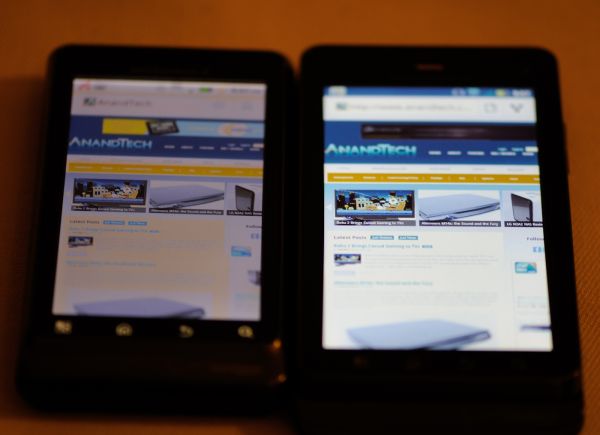
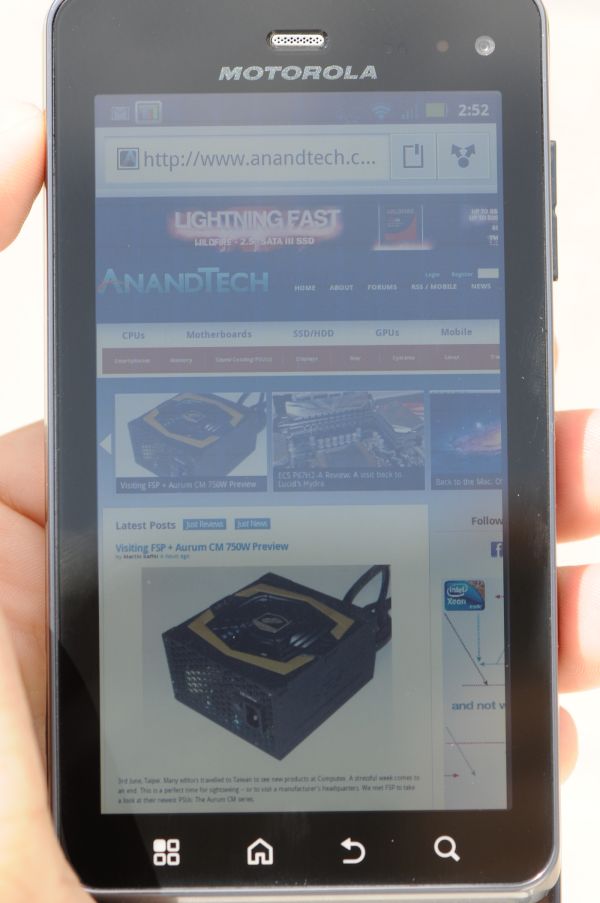








84 Comments
View All Comments
7amood - Saturday, July 30, 2011 - link
that's nice to hearplease don't forget to talk about the screen problem
http://www.gsmarena.com/samsung_galaxy_s_ii_displa...
It's really hard to accept that my perfect SUPER AMOLED is not perfect.
It's harder to accept the fact that samsung don't give a f*** about me since they already have my money.
takumsawsherman - Saturday, July 30, 2011 - link
On the GL benchmark, it shows iPhone 3GS running faster than iPhone 4. Is this correct? If so, why do you think iPhone 4 is performing worse on the test?Ryan Smith - Sunday, July 31, 2011 - link
GLBench runs at the device's native resolution. The iPhone 4 is 4x the resolution of the 3GS.Lucian Armasu - Sunday, July 31, 2011 - link
It looks like OMAP is on the way out from the market, though:http://semiaccurate.com/2011/07/29/texas-instrumen...
Now the fight will be left between Nvidia, Qualcomm and Samsung.
martyrant - Sunday, July 31, 2011 - link
My VP wanted one, so we both got one the same day. I don't talk on the phone as much, but after a week I did a conference call on it and it drained it from 80% to 15% in under an hour. I also just left it on a charger last night, saw it go from 30-90%, went to bed, got up and just checked it (while still plugged into the charger) and it's back at 30%. Did you see any strange anomalies when running your battery life tests? My VP loves the phone, but hates the battery--his dies all the time and so does mine. It seems like while your tests look awesome, the real life performance of this phone is nowhere near in line with those tests when it comes to battery. I have tried max battery saver, just about everything---had to get the VP an extended battery pack and he still doesn't know if he can continue to use this phone because of the battery issues.martyrant - Sunday, July 31, 2011 - link
It went to 20% from 30% while writing that comment, while plugged into the charger. Hot, right?josby - Sunday, July 31, 2011 - link
Same here. I bought mine the day they were released in stores, but I've been anxiously awaiting the AnandTech review of it because I knew it would include battery life comparisons. I came from a T-Mobile G2 (running Cyanogen7) and have all the same apps, with the same update intervals set, on my Droid3 as I had on the G2, yet the battery life is very noticeably worse. It can barely make it from morning til night even with very light usage.In fact, I always left my G2's wifi on, yet the Droid3 still doesn't last as long even if I leave wifi off.
Yet, the G2 does considerably worse than the Droid3 in the battery life tests in this review.
Brian Klug - Sunday, July 31, 2011 - link
That's odd - I wonder what kind of signal environment he was in when he made that call. Could you find out what Rx signal strength was in dBm?The only part of the entire cellular architecture that has a power control loop is the phone->base station, and when you're in a low signal environment the phone can increase Tx power to be "heard" by the base station and thus hurt battery life considerably. We always test in areas with at least -75 dBm or better.
-Brian
photoguru - Monday, August 1, 2011 - link
I had major problems with my battery life until I realised that the power adapter for the Droid 3 requires 5.1v at 850mA which is quite a bit higher than most chargers. Mine actually died while browsing the web and being plugged into a Belkin usb charger.Also, theres an issue with programs not turning off once you exit them. Task killers should fix it but I actually just went through the programs and manually adjusted which ones can continue to run in the background. Now my battery lasts almost twice as long as it did before, and quite a bit longer than my droid 1 and droid 2 global.
anandtech pirate - Sunday, July 31, 2011 - link
how about the Evo3D?